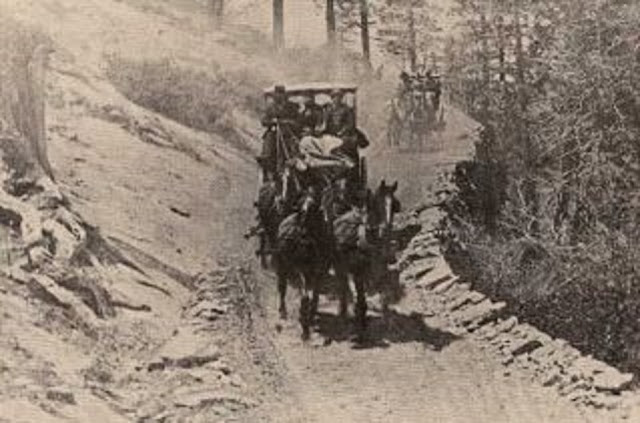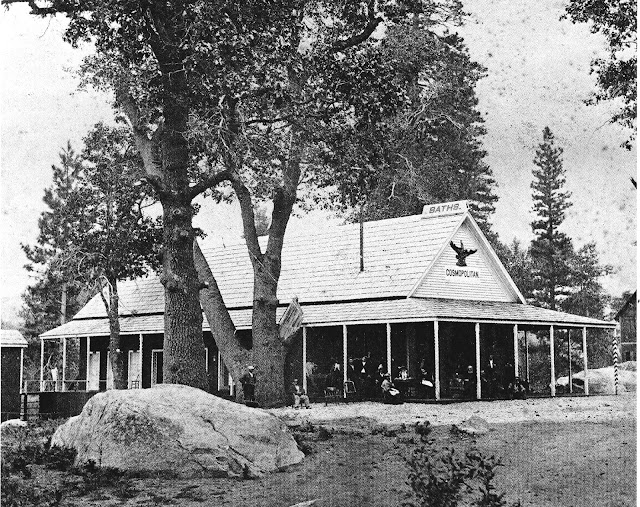A TRIP TO YO-SEMITE IN 1874 - PART 4
So last week we left my great grandfather and his fellow
Yo-Semite bound travelers in First Garrote drinking water from a fine roadside
stream.
This week the party will reach the northern boundary of Yo-Semite and continue on toward the Valley. A quick reminder: J.K.’s words from his journal are in black; my remarks are in blue; and the remarks of Helen Hunt Jackson, who made the same trip two years before J.K. did, are in pink. And away we go . . .
A little on (from First Garrote) is the saw mill where we met two stages outward bound. At 11:38, on rising a hill, first saw the Yo-Semite mountains with snow. Passed the fork and canyon of the Tuolumne, which is grand indeed. This would be the area of the current Rim of the World vista point.
Next stop was Colfax Springs. Beyond there, they would have crossed the south fork of the Tuolumne River through a covered bridge above what is now Rainbow Pool and then climbed Hardin Hill.
We arrived at Colfax Springs, the worst place on all the route, at 12PM and left at 2PM, arriving at Hodgen's (Hodgedon's) at 5:00. The hotel was full, so slept on a shake down. Sutton slept in the corral. Wouldn't sleep with anyone, and nearly froze to death in the haymow.
Hodgedon’s now. I’m
assuming they ate supper at Hodgedon's, but J.K. doesn't mention anything about
it.
Helen Hunt Jackson, however, who
made this same trek two years earlier, had this to say about the "grovelling misery" of a night at “Hogdin's,
'G' soft, but not by rights! It was only
half-past 5 o'clock when we arrived. The two shanties of which Hogdin's
consists were already filled. Unhappy
men and women, sitting on log steps with their knees drawn up, glared at us
savagely as brigands might. They were wretched enough before. Now we had come. What would be done? How many to a room would it make? And where-withal were we to be fed? Three,
four, five in a room; some on floors without even a blanket. Women with tin pans for washbowls and one
towel for six hands. The men, with one
tin basin in an open shed and if they had any towel or not, I do not know. That was a night at Hogdin's. Food? Yes.
Junks of beef floating in bowls of fat, junks of ham ditto, beans ditto,
potatoes as hard as bullets and the whole set out in indescribable confusion
and dirt in a narrow, unventilated room dimly lit by two reeking kerosene
lamps. Even brave and travelled souls
could not help being appalled at the situation."
Sunday morn, the 24th and beautiful. Started for the Valley. Saw a bear, but as we had not lost any, we let him go. (a joke of some sort, I guess?) Passed the Tuolumne Grove of Big Trees, and into Crane's Flat. Arrived at Cabin's (Gobin's). Took saddle animals. Sutton in trouble again – had the poorest animal in the party.
I was surprised
J.K. didn’t elaborate on the Tuolumne Grove of Big Trees. They were every bit
as huge as those in the Calaveras Big Trees grove, but perhaps having seen the
big trees in the Calaveras Grove, the Tuolumne Grove was simply a repeat so
ho-hum. Doesn’t sound like J.K., but he
didn’t say much about them other than that they’d passed them. Oh well.
Now comes the snow - plunge we go, pack animals get down and up again. Arrived at Tamarack Flat, 12:30 for lunch which most cabbaged (procured) at old Mother Hodgen's. (?) From Yosemite Park’s historical archives, this would have been a rude hotel at Tamarack Flat called Tamarack House maintained by Alva Hamilton starting in 1870, before completion of the Big Oak Flat Road to the floor of Yosemite Valley, where tourists and pack train handlers obtained meals. Business at Tamarack House fell off drastically in the mid-1870s as soon as stages could go on through to the Valley on the Big Oak Flat Road.
Now
comes the snow - plunge we go, pack animals get down and up again. Arrived at Tamarack Flat, 12:30 for lunch
which most cabbaged (procured) at old Mother Hodgen's. From Yosemite Park’s historical archives, this would have been a rude hotel at
Tamarack Flat called Tamarack House maintained by Alva Hamilton starting in
1870, before completion of the Big Oak Flat Road to the floor of Yosemite
Valley, where tourists and pack train handlers obtained meals. Business at Tamarack House fell off
drastically in the mid-1870s as soon as stages could go on through to the Valley
on the Big Oak Flat Road.
A typical saddle train making their way down to the Valley.
His description of their trek down the cliff is
good. But Helen Hunt Jackson went a bit
further, saying even having seen how steep it looked when other horses and
riders disappeared over the crest of the hill, it felt steeper. “To an unaccustomed rider it is not pleasant to sit on a
horse whose heels are much higher than his head. The first two and a half miles
of the path down the wall of the cliff are steep - so steep that it is best not
to try to say how steep. It is a
narrow path, zigzagging down on ledges, among boulders, through thickets. It is dusty and stony and comes out suddenly
on opens from which you look over and down thousands, yes, thousands of feet. It plunges into tangles of trees where a rider
must lay his head on the horse's neck to get through, for oaks and firs and
pines grow on this precipice. In some
places the rocks are bright with flowers and ferns which look as if they are
holding on for dear life.”
Just beyond Gentry’s as they started down the saddle trail to
the Valley floor, they would have come upon this scene called “Inspiration” or
“Oh my!” point with El Capitan on the left and “Half Dome” in the center.
Had J.K. waited until mid July that year to make his trip, not
only would he and his party been able to take their carriage all the way down
to the Valley instead of having to go the rest of the way from Gobin’s by
saddle train, but they would have missed the snow. Here’s a sample of the wagon road they would
have taken . . .
We had
some fun crossing the Merced River. The
water had risen several feet and the bridge was floating. The pack animals were shoved into the stream,
while our saddle animals were urged to move on.
Old Comanche took me through safely, while Pixley mule gave my friend,
Clark, a ducking.
Area of Hutchings Hotel now.
In the
evening we all met at Smith's where we had a jolly chat over our mint juleps (a tall cool drink of
bourbon whiskey with sugar, crushed mint leaves, & shaved ice). Then Clark
and I took a stroll down the river – it presented a lovely mirror view, the
mountains west and Yo-Semite Falls being plainly reflected. It was arranged to visit Vernal and Nevada
Falls next day, the 25th.

























Another remarkable blog in this series! I can't imagine folks making this trip, given the challenges of food and housing -- particularly women, with those long dresses. But adventurousness seems to know no bounds, as your ancestor's journal attests. Looking forward to the next installment!
ReplyDeleteThis episode was a real treat to read! I've followed JK's route on Google Maps to understand the difficult terrain he and his companions traveled and to see more views of the landscape. This past winter I got hooked watching YouTube channels devoted to the incredible snowstorms in the Sierras and I've watched similar videos of torrential flooding in Yosemite Park. It's hard to understand how people survived living there in earlier times. I also can't imagine the effort it took to build such an extravagant tourist resort in Yosemite back then. Fortunately John Muir helped save beautiful places like this for posterity and future generations.
ReplyDelete